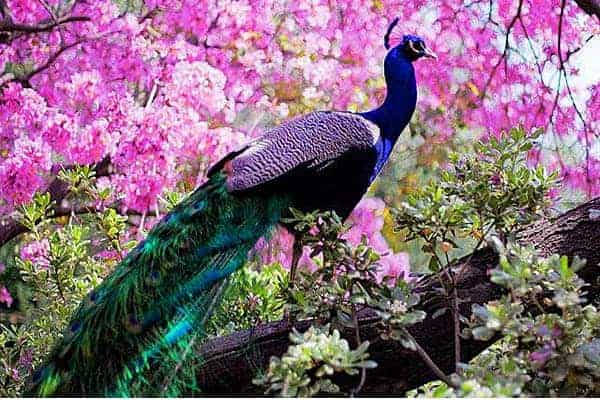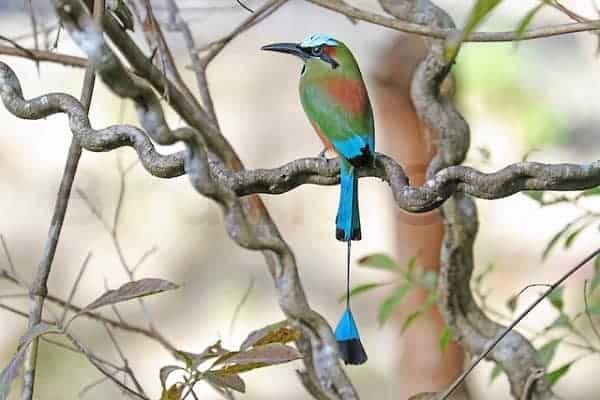Small birds with long tails are a special group of birds that enchant us with their beauty and charm. They have amazing lifestyles, habits, and mating rituals that we’ll discover in this book.
We’ll explore eleven incredible species, from the elegant Fork-tailed Flycatcher to the exotic White-tailed Tropicbird. You’ll learn their secrets, fun facts, and what makes them unique in the world of birds.
Types Of Small Birds With Long Tails (Names + Info)
1. Fork-tailed Flycatcher

Appearance and Habit
The Fork-tailed Flycatcher, known for its sharp black-and-white plumage, is a master of the sky. These small birds measure about 9 inches in length, including their distinctive long forked tail. Their streamlined bodies enable them to navigate the air with remarkable agility.
Breeding and Nesting
These birds are known for their migratory habits. They breed in South America, with males building intricate nests to attract females. Their nests are architectural marvels, often hanging from tree branches like delicate ornaments.
Fun Fact
Fork-tailed Flycatchers are known to be highly territorial during the breeding season, often chasing away much larger birds that come too close.
Behavior
They are voracious insect-eaters, adept at catching prey mid-air. Their long tails aid in aerial acrobatics, helping them change direction swiftly.
2. Greater Bird-of-Paradise

Appearance and Habit
The Greater Bird-of-Paradise, native to New Guinea, is a strikingly colorful bird. Their plumage boasts a vibrant mix of iridescent blues and yellows, and their long, elegant tail feathers resemble a cascade of silk.
Breeding and Nesting
During mating rituals, males perform elaborate dances, showcasing their stunning tail feathers to attract females. Nests are often built in trees, and males meticulously decorate their surroundings to impress potential mates.
Fun Fact
The Greater Bird-of-Paradise is known for its peculiar courtship dance, which involves acrobatic displays and synchronized movements.
Behavior
These birds are primarily frugivorous, relying on fruits as their main food source. Their long tails serve as displays of their vitality and genetic fitness.
You May Want to Read: Blue Birds In Pa (Pennsylvania)
3. Indian Peafowl

Appearance and Habit
The Indian Peafowl, often simply called the Peacock, is one of the world’s most iconic birds. With its iridescent blue-green plumage and a mesmerizing train of elongated tail feathers, the male Peacock is a true spectacle.
Breeding and Nesting
Peafowls display their tail feathers in vibrant fan-like displays during the mating season to attract peahens. Nests are simple ground scrapes, and the female lays her eggs there.
Fun Fact
Peafowls are not only known for their dazzling appearance but also for their unmistakable, shrill calls that echo through the forests.
Behavior
Peafowls are omnivores, and their long tails are not just for show; they aid in balance and are useful for escaping predators.
4. Long-tailed Widowbird

Appearance and Habit
The Long-tailed Widowbird is an African bird with strikingly long, black tail feathers that can measure up to 20 inches. The males sport these extravagant tails during the breeding season.
Breeding and Nesting
To woo females, males perform gravity-defying aerial displays, showing off their impressive tails. Nests are built near the ground in grassy areas.
Fun Fact
Males undergo a molting process post-breeding season, shedding their long tail feathers to assume a more inconspicuous appearance.
Behavior
These widowbirds feed primarily on seeds and insects, using their long tails for precise flight control.
5. Marvelous Spatuletail

Appearance and Habit
The Marvelous Spatuletail is aptly named for its extraordinary tail. This hummingbird, native to Peru, possesses a unique pair of elongated feathers that resemble tiny spatulas.
Breeding and Nesting
During courtship, males display their spatuletail feathers in mesmerizing, intricate dances. Nests are often built on tree branches, offering protection for their delicate eggs.
Fun Fact
The Marvelous Spatuletail is critically endangered due to habitat loss, making it a rare and cherished sight for birdwatchers.
Behavior
Their long tail feathers are essential for balance during hovering while they feed on nectar from flowers.
Must Read: Can Parrots Eat Chicken?
6. Reeves’s Pheasant

Appearance and Habit
Reeves’s Pheasant, native to China, showcases a breathtaking combination of colorful plumage and a long, elegant tail. Males are particularly striking with their iridescent hues and long tail feathers.
Breeding and Nesting
Males perform flamboyant displays during courtship, showcasing their vibrant tails. Nests are often hidden in dense vegetation, offering safety for the eggs.
Fun Fact
Reeves’s Pheasants are known for their elusive nature, often remaining hidden in the dense underbrush.
Behavior
These birds are omnivorous, feeding on a diet of seeds, fruits, insects, and small animals. Their long tails are used for balance and courtship displays.
Related Article: Small Birds with Long Wings
7. Resplendent Quetzal

Appearance and Habit
The Resplendent Quetzal, found in Central America, is an emblematic bird known for its vivid green plumage and exceptionally long tail feathers.
Breeding and Nesting
During the breeding season, males display their vibrant tails in intricate aerial displays. Nests are typically found in tree cavities.
Fun Fact
The ancient Mayans revered the Resplendent Quetzal as a symbol of freedom and goodness, and they considered it illegal to kill the bird.
Behavior
These birds primarily feed on fruits and insects, using their long tails for stability during flight and courtship rituals.
Related Article: Small Birds with Long Legs
8. Ribbon-tailed Astrapia

Appearance and Habit
The Ribbon-tailed Astrapia, native to Papua New Guinea, boasts one of the longest tails in the avian world. Males have tail feathers that can extend to over three feet in length.
Breeding and Nesting
Males use their impressive tail feathers during courtship to impress females. Nests are located in trees, often at considerable heights to ensure safety.
Fun Fact
The Ribbon-tailed Astrapia is so elusive that it was only discovered in the early 20th century.
Behavior
These birds primarily feed on nectar and insects and use their long tails for balance during foraging and courtship displays.
Also Visit: Hummingbirds in Maryland
9. Superb Lyrebird

Appearance and Habit
The Superb Lyrebird, native to Australia, is known for its exceptional ability to mimic sounds and its striking tail feathers.
Breeding and Nesting
Males create intricate mounds of dirt and debris for their displays, often accompanied by mimicked sounds. Nests are built near the mound.
Fun Fact
The Superb Lyrebird can mimic a wide range of sounds, including camera shutters, chainsaws, and even other bird species.
Behavior
Their diet includes insects and small invertebrates, and their long tail feathers play a crucial role in courtship displays and stability.
10. Turquoise-browed Motmot

Appearance and Habit
The Turquoise-browed Motmot, found in Central America, is known for its striking turquoise feathers and its distinctive long tail feathers with a unique racket-shaped tip.
Breeding and Nesting
Males perform courtship displays, showcasing their racket-shaped tail feathers to attract females. Nests are typically found in tunnels dug into earth banks.
Fun Fact
Turquoise-browed Motmots have a habit of plucking their tail feathers, a behavior still not entirely understood.
Behavior
Their diet consists of insects, fruits, and small reptiles, and their long tails are used for stability while hunting and courtship.
11. White-tailed Tropicbird

Appearance and Habit
The White-tailed Tropicbird, found in tropical oceans, is known for its graceful white plumage and its elongated white tail feathers.
Breeding and Nesting
These birds engage in dramatic aerial displays during courtship, using their tail feathers to great effect. Nests are located on cliffs or rocky outcrops.
Fun Fact
The White-tailed Tropicbird is often seen as a symbol of freedom and is the national bird of Bermuda.
Behavior
Their diet primarily consists of fish, and their long tail feathers are crucial for maneuvering in the air and attracting mates.
Frequently Asked Questions About Long-Tailed Birds
Q1: Which bird has long tails?
Birds with long tails are found across various species. Some examples include the Indian Peafowl, the Greater Bird-of-Paradise, and the Ribbon-tailed Astrapia. These birds have strikingly long tail feathers used for various purposes, from courtship displays to balance during flight.
Q2: What is a small white bird with a long tail?
A small white bird with a long tail could be the White-tailed Tropicbird. This elegant bird is known for its graceful white plumage and elongated white tail feathers.
Q3: What is a brown bird with a long tail?
A brown bird with a long tail might refer to the Long-tailed Widowbird. These African birds have predominantly brown plumage with strikingly long black tail feathers during the breeding season.
Final Thoughts:
Small birds with long tails are a testament to the diversity of avian life. These birds not only enchant us with their exquisite appearances but also inspire us with their unique behaviors, courtship rituals, and survival strategies. From the graceful White-tailed Tropicbird to the elusive Ribbon-tailed Astrapia, each species has a story worth exploring. Their long tails are not just adornments but essential tools for their lives in the wild.
